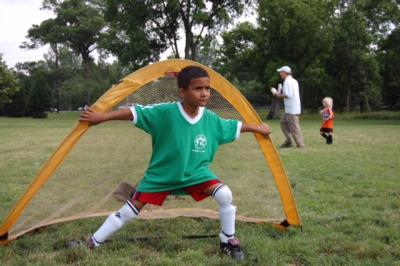WASHINGTON, DC (July 10, 2014) — If you think winning is one of the key determinants that makes organized sports fun for kids think again: Winning along with other mental bonuses ranked near the bottom of 81 determinants of fun, each of which falls into one of 11 big fun factors, according to a new study. Despite the common belief that winning is all important when it comes to the "fun" factor, very little research had been done to actually identify and quantify what goes into this elusive concept—until now.
The results of this study might help researchers develop proven ways to keep kids involved in organized sports, which can help maintain a healthy body weight. Right now, more than one out of three U.S. children and adolescents are overweight or obese and many drop out of organized sports early in life—often saying the activity just isn't fun anymore.
In this first of a kind study, Amanda J. Visek, PhD, associate professor of exercise science at Milken Institute School of Public Health (Milken Institute SPH) at the George Washington University and her research team used a method called concept mapping in order to map "fun" in youth sport.
First, they asked 142 soccer players, 37 coaches and 57 parents to identify all of the things that make playing sports fun for kids. When all of their ideas were pooled and synthesized, 81 specific determinants of fun were identified. Next, the study participants were asked to sort the 81 fun-determinants in a way that made sense to them and then finally to rate the determinants on their importance, frequency and feasibility.
The study showed that:
- There are four fundamental tenets to creating fun – that is, there are internal, external, social and contextual factors that make up the complete fun experience for kids.
- The 11 fun factors lie within the fundamental tenets and include Being a good sport, Trying hard, Positive coaching, Learning and improving, Game time support, Games, Practices, Team friendships, Mental bonuses, Team rituals, and Swag.

A new study identifies the top factors that make organized sports fun for kids.
(Photo Credit: JOHN GARDINER/DC Stoddert Soccer, Inc.)
- The 11 fun factors are each defined by the various 81 fun-determinants – specific, actionable behaviors that foster fun.
- Among the 11 fun factors, Being a good sport, Trying hard, and Positive coaching were the most important when it comes to fun; together, these three factors were coined the "youth sport ethos" – a collection of 28 fun-determinants that set the standard for promoting a culture of fun.
"When the FUN MAPS are viewed three-dimensionally, the youth sport ethos becomes very apparent. Most remarkably, Being a good sport, Trying hard and Positive coaching came in as the top three most important factors to having fun," says Visek. "At the same time, Swag—such as having a cool uniform or the latest sports gear—was rated as the least important determinants of fun."
The full results of this innovative study appeared July 10 online in the Journal of Physical Activity & Health. All of the study participants were involved in organized youth soccer programs in the larger Washington, D.C. metropolitan area; however, over 75 percent of the kids that participated in the study also played sports other than just soccer. "It was important to us, particularly at the brainstorming stage of the study when the participants generated their ideas of all of the things that make playing sports fun that they identified as many things as they could within the entire scope of their youth sport experiences. In the end, the FUN MAPS essentially provide youth sport with a road map to fun," says Visek.
The results of this study are important and timely given that the number one reason kids drop out of organized sport is because it is not fun anymore. In fact, about 70 percent of kids drop out of organized sports by the time they reach middle school—a statistic that worries public health officials because it is thought to contribute to the rising prevalence of obesity and physical inactivity in the United States.
This study helps clarify what really matters when it comes to having a good time playing the game, and can help coaches and leagues inject more fun into the overall sport experience in order to keep kids playing. "Coaches, parents, and youth sport administration should take the findings into account when organizing and running sports leagues for kids," says Heather Manning, a research associate at Milken Institute SPH, that has worked closely with Visek over the last year analyzing the study's findings.
An estimated 60 million boys and girls participate in organized sports and public health researchers hope to discover elements that will help keep them involved for the long haul.
"Keeping kids involved in sports in childhood and throughout their adolescence would be a significant public health breakthrough. The FUN MAPS can help do that. As a public health practice, sport participation can be a major source of physical activity and as such offers the well documented benefits of regular exercise. This is particularly important for children and adolescents," says Visek. "Moreover, the longer we can keep them participating in sport, the greater likelihood we have of helping them establish a habit of regular physical activity for the rest of their lives."
Source: George Washington University Milken Institute School of Public Health